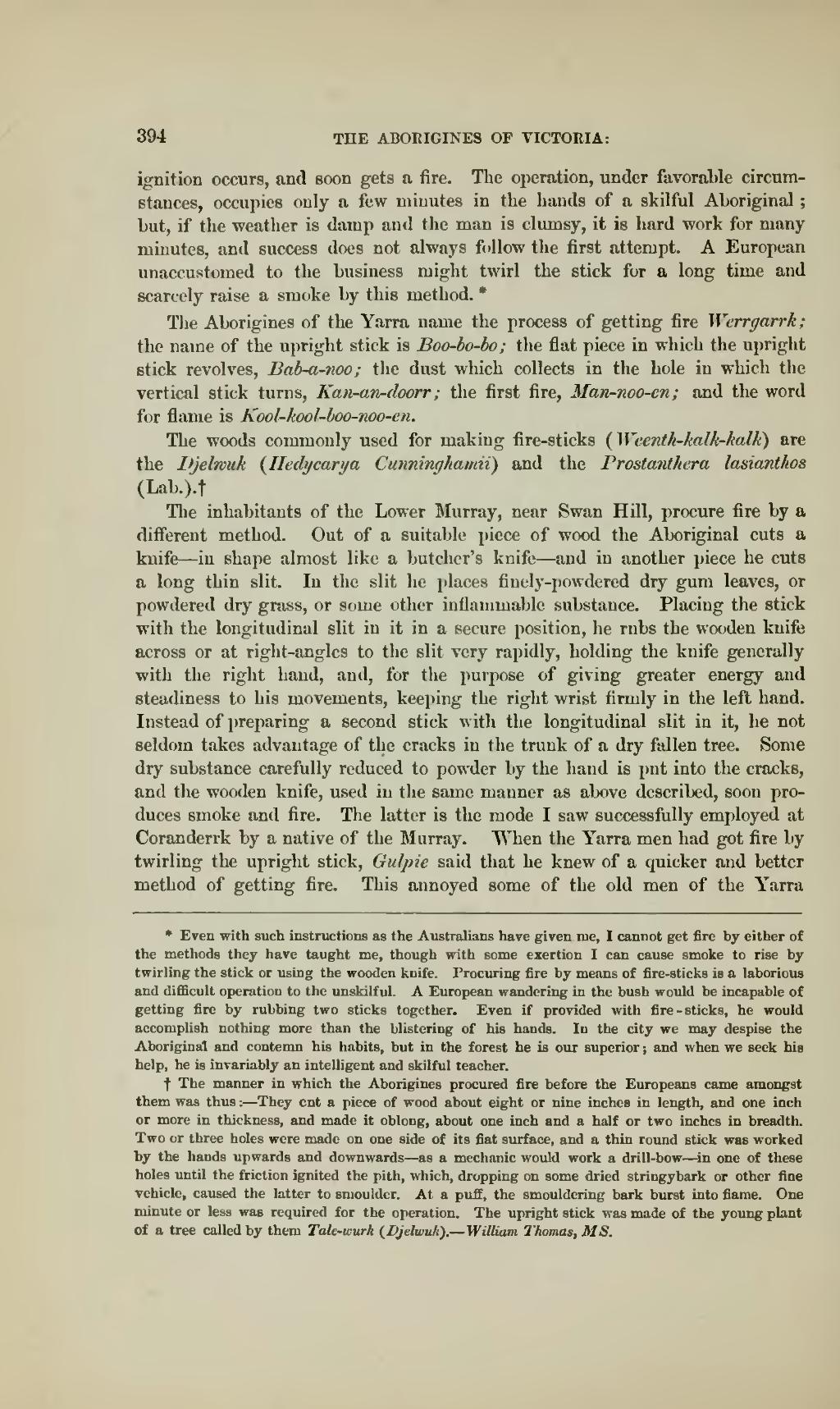ignition occurs, and soon gets a fire. The operation, under favorable circumstances, occupies only a few minutes in the hands of a skilful Aboriginal; but, if the weather is damp and the man is clumsy, it is hard work for many minutes, and success does not always follow the first attempt. A European unaccustomed to the business might twirl the stick for a long time and scarcely raise a smoke by this method.[1]
The Aborigines of the Yarra name the process of getting fire Werrgarrk; the name of the upright stick is Boo-bo-bo; the flat piece in which the upright stick revolves, Bab-a-noo; the dust which collects in the hole in which the vertical stick turns, Kan-an-doorr; the first fire, Man-noo-en; and the word for flame is Kool-kool-boo-noo-en.
The woods commonly used for making fire-sticks (Weenth-kalk-kalk) are the Djelwuk (Hedycarya Cunninghamii) and the Prostanthera lasianthos (Lab.).[2]
The inhabitants of the Lower Murray, near Swan Hill, procure fire by a different method. Out of a suitable piece of wood the Aboriginal cuts a knife—in shape almost like a butcher's knife—and in another piece he cuts a long thin slit. In the slit he places finely-powdered dry gum leaves, or powdered dry grass, or some other inflammable substance. Placing the stick with the longitudinal slit in it in a secure position, he rubs the wooden knife across or at right-angles to the slit very rapidly, holding the knife generally with the right hand, and, for the purpose of giving greater energy and steadiness to his movements, keeping the right wrist firmly in the left hand. Instead of preparing a second stick with the longitudinal slit in it, he not seldom takes advantage of the cracks in the trunk of a dry fallen tree. Some dry substance carefully reduced to powder by the hand is put into the cracks, and the wooden knife, used in the same manner as above described, soon produces smoke and fire. The latter is the mode I saw successfully employed at Coranderrk by a native of the Murray. When the Yarra men had got fire by twirling the upright stick, Gulpie said that he knew of a quicker and better method of getting fire. This annoyed some of the old men of the Yarra
- ↑ Even with such instructions as the Australians have given me, I cannot get fire by either of the methods they have taught me, though with some exertion I can cause smoke to rise by twirling the stick or using the wooden knife. Procuring fire by means of fire-sticks is a laborious and difficult operation to the unskilful. A European wandering in the bush would be incapable of getting fire by rubbing two sticks together. Even if provided with fire-sticks, he would accomplish nothing more than the blistering of his hands. In the city we may despise the Aboriginal and contemn his habits, but in the forest he is our superior; and when we seek his help, he is invariably an intelligent and skilful teacher.
- ↑ The manner in which the Aborigines procured fire before the Europeans came amongst them was thus:—They cut a piece of wood about eight or nine inches in length, and one inch or more in thickness, and made it oblong, about one inch and a half or two inches in breadth. Two or three holes were made on one side of its flat surface, and a thin round stick was worked by the hands upwards and downwards—as a mechanic would work a drill-bow—in one of these holes until the friction ignited the pith, which, dropping on some dried stringybark or other fine vehicle, caused the latter to smoulder. At a puff, the smouldering bark burst into flame. One minute or less was required for the operation. The upright stick was made of the young plant of a tree called by them Tale-wurk (Djelwuk).—William Thomas, MS.

